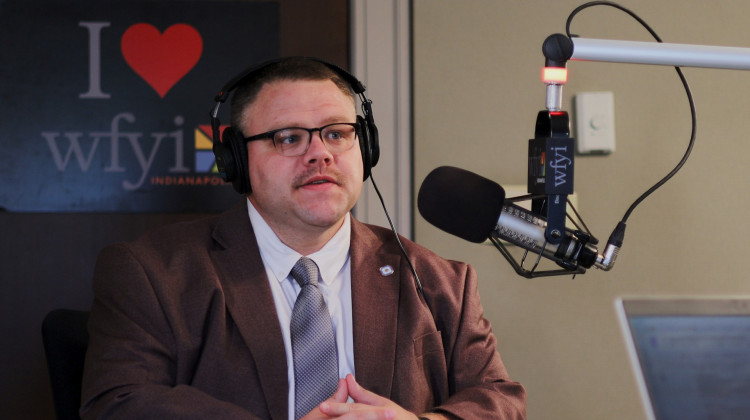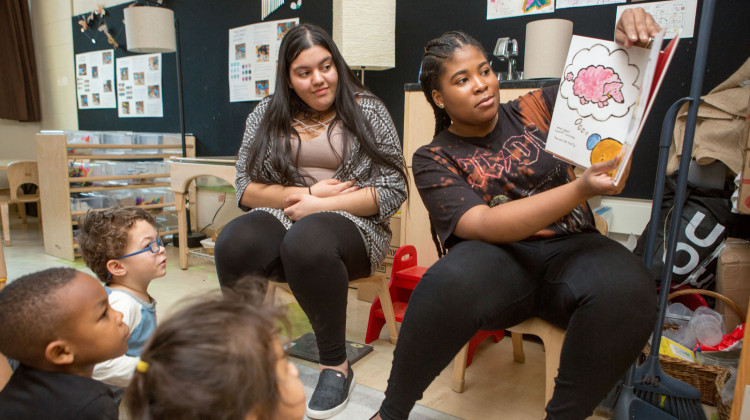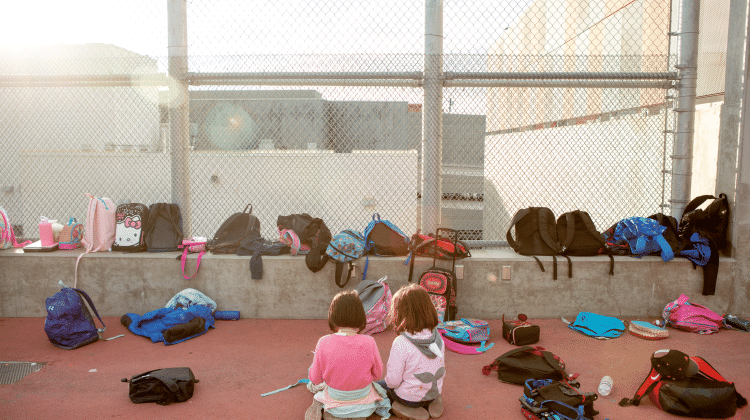
Mary E. Nicholson School 70, 510 E. 46th St. on the Northside of Indianapolis.
Eric Weddle / WFYI Public MediaAn Indianapolis Public School Board member Tuesday called for a 30-day waiting period before the district takes actions to make major changes to schools in the wake of a plan to move an arts magnet program.
The meeting was briefly interrupted when criticism of the board was deemed inappropriate and one speaker was escorted out of the building.
Under the plan, Key Learning Community would become an arts magnet program. The principal, teachers and materials would move from School 70 on the city’s North side to Key, located just west of downtown. After Cosby’s objection, the board delayed a planned vote on changes at School 70 until Nov. 9. It still plans to vote on the other changes on Thursday.
Key’s groundbreaking project learning-based program would close down, and the district’s middle school arts programs would move to the new magnet school, removing those grades from Broad Ripple High School, an arts magnet for grades 6-12.
After the board discussed the plan at a work session last week, parents at School 70 complained that they had not had an opportunity to give input on the plan. Parents and community leaders criticized the board at the meeting.
School 70 parent Laura Powell said her family picked the nearby school for their daughter because it was the neighborhood school, and they have been impressed by the quality of the arts program.
“I’m quite upset the school is likely to be moving,” she said. “I’d ask you if you could push the pause button on this thing so more community input could be gathered.”
An Indianapolis pastor, the Rev. David Greene, was even more critical, likening the surprise decision to move the arts program to being drugged and date-raped.
“There’s a clear message that the voices of parents and people are no longer of interest to IPS,” he said.
That preceded comments from Larry Vaughn, a one-time school board candidate and frequent protester at public meetings. Vaughn was critical of black board members, calling them “child molesters” for supporting policies he said hurt children. That brought five police officers and the head of security to the podium to escort him out.
Board member Sam Odle backed Cosby’s proposal to require a 30-day period to gather input for big changes to schools, such as those proposed for School 70, Key and Broad Ripple, that would “reconstitute, relocate or close” a school.
“I think that is definitely a good move,” he said.
Meetings are planned at the three schools for next week to share information with parents. He proposed putting off Thursday’s vote until after those meetings.
“After those appropriate meetings are had in the community, we look to the administration to bring a recommendation back to the board,” he said.
Board member Mary Ann Sullivan, however, said the board should get legal advice to accomplish Cosby’s goals but be sure the new rule doesn’t tie the board’s hands.
Cosby said she also had broader concerns about the district’s policy for how it assigns students to magnet schools, which she said exacerbated racial imbalance and prevented black and Hispanic children from having opportunities to attend the magnets that have the highest demand.
The magnet priority system gives the most weight, in order, to siblings of children attending magnet schools, those who live closest to the school and IPS employees.
'Powerful Language'
Cosby argued that has led to three CFI schools with student enrollments that are 35 percent, 67 percent and 82 percent white in a district where white students make up just 20 percent of students overall. About half the district’s students are black, but the percentage of black students at the three CFI schools are 46 percent, 15 percent and 7 percent.
“This current tiered system of preference does nothing but perpetuate huge gaps in access for children of color,” Cosby said.
Cosby said she objected to a revision to the system that diminished an emphasis on promoting racial balance in IPS schools.
“I hate the fact that we are losing this language,” she said. “It’s powerful language.”
Superintendent Lewis Ferebee said he did not feel comfortable reassigning students, for example, to achieve racial balance, but Cosby said the policy also suggests ramping up recruiting of under-represented groups when schools get out of balance.
“We’re not an integrated district yet,” she said. “We need to continue to have policy that works toward that end goal.”
Ferebee said his main concern was a policy that required the superintendent to reassign students for racial balance, which he said he believed violated court rulings. But he agreed that recruiting students to magnet schools was likely permitted.
IPS wants to ensure students have access to their neighborhood schools, he said.
Two of the three CFI schools are located in North side neighborhoods that serve more white students. Administrators have said adding a fourth CFI school could help relieve a wait list for the three schools that has more than 300 students.
The proposed moves, Ferebee said, also should help the arts program by locating it near downtown arts centers and making it easier for children to attend an arts elementary school until they reach ninth grade, rather than move to Broad Ripple High School at sixth grade.
“This is a strategic effort to bolster the vision for performing and visual arts in the district,” he said. “I believe a barrier to the growth of performing and visual arts is the odd configuration of K-5 (at School 70) to 6-12 (at Broad Ripple). We need to be strategic about the facility we utilize to be sure students have the experience we want them to have as it relates to performing and visual arts.”
Board President Diane Arnold said Ferebee was only trying to take steps to accomplish two board directives: to move away from combined middle and high schools and to expand successful magnet programs to more schools.
“This just didn’t come out of the blue,” she said. “This is something this board has charged this administration with.”
Chalkbeat Indiana is a nonprofit news site covering educational change in public schools.
 DONATE
DONATE





 View More Articles
View More Articles




 Support WFYI. We can't do it without you.
Support WFYI. We can't do it without you.